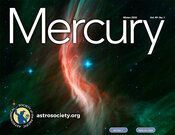Winter 2020 - Volume 49, Number 1

Table of Contents
[9] Space News
A rundown of some of the most exciting developments in space and time.
[28] Cosmic Views, Jason Major
Take a close-up view of our Sun’s photosphere and admire a massive asteroid fit for the driving range.
[30] Red Planet Rush
A quartet of space probes is heading to Mars soon looking to answer lots of new questions—and an old one.
[36] Goodbye, Spitzer
After 16 years of reshaping our view of the infrared universe, NASA’s “little telescope that could” has been decommissioned.
Departments:
[3] Perspectives, Ian O’Neill
This Is Goodbye (for now)
[4] First Word, Linda Shore
In Memory of Katherine Johnson
[11] Annals of Astronomy, Clifford J. Cunningham
The “Black Death Scapegoat Conjunction” of 1345
[13] Astronomer’s Notebook, Jennifer Birriel
The Brown Dwarf Desert
[15] Armchair Astrophysics, Christopher Wanjek
Cosmic Expansion Just Got More Complicated
[17] Research Focus, M. Katy Rodriguez Wimberly
How Much Do We Actually “Weigh”?
[19] Research Focus, James Negus
Nuclear Star Clusters and Galactic Evolution
[22] Education Matters, Brian Kruse
Unpolluted Skies: A Human Right?
[24] A Little Learning, C. Renee James
Mission Accomplished
[42] Reflections, Ian O’Neill
Time for “T” on Mars
Red Planet Rush (Feature)
By Steve Murray
This year kicks off a busy decade for Mars. Four missions will transport two landers, three rovers, and two orbiters to the Red Planet, taking advantage of the biennial alignment that makes for a shorter trip. More capable instruments will tackle new science questions and dig deeper into an old one: was there ever life on Mars?
Goodbye, Spitzer (Feature)
By Sarah Wells
The mood was bittersweet as hundreds of scientists, engineers, friends and family spilled into the Jet Propulsion Laboratory’s (JPL) Pickering Auditorium on January 30th in Pasadena, Calif. The crowd itself was a testament to the mission they’d come to celebrate: the Spitzer Space Telescope. Described by many involved with the project as the “little telescope that could,” Spitzer was a telescope that pushed scientific boundaries and, for many in the auditorium that day, spanned a significant part of their lives and scientific careers. After a successful (and, at times, harrowing) 16-years on the job, Spitzer was placed into safe mode and the mission was declared finished at 2:30 p.m. PST.
